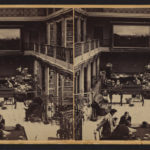The recent publication of הספרים של הגטו The books of the Ghetto. Catalog of the Hebrew books of Jewish Community of Venice (16th-20th centuries), Chiara Camarda ed. (Il Prato, Padua 2016) presents a detailed description of the heritage of Jewish books owned by the Jewish Community Library of Venice.
This collection embodies the important tradition of book production from an era when Jewish bookmaking in Venice radically transformed Jewish culture and the dynamics of its transmission. Over fifty per cent of early Jewish publishing was produced in Venice.
The various printing facilities – owned by Christian entrepreneurs – were the site of intense cultural exchanges between intellectuals, rabbis, proofreaders, typesetters, and composers. Printshops became a point of encounter among Jews, Christians, and Marranos.
This presentation, which includes some of the most significant books in the Venetian library, is meant as a window on a diverse world and its cultural production. It shed light on the period immediately preceding the invention of movable type and on the historical context in which written text circulated only through manuscripts among restricted circles of users.
The introduction of the printing press revived the production of manuscripts used for liturgical purpose and philosophical exchanges and that were not widely circulated.
Three of the most precious manuscripts owned by the Venetian Library, are featured in this exhibition, attesting to the continuity of the culture and importance of writing that accompanied the unfolding of Jewish tradition. These manuscripts are now transformed in multimedia form and made to a wider audience.
Venetian library treasures spanning from the earliest book printed in the city to the last one, from 1521 and 1862.
Renato Maestro Library, photos by Mayank Austen Soofi
Like most Jewish libraries and museums in Italy, the Renato Maestro Library’s collection of manuscripts and books, increased over the centuries, shaped by the development of the learning and religious institutions of the Jewish community of Venice.
Not only were these books used by Venetian Jews and non-Jews but were also printed in Venice, as a result of exchanges and negotiations with the ruling powers as well as of an effort of self-representation and control that developed within the Jewish minority.
Titles span from prayer books to juridic text, biblical and Talmudic literature, and grammars.
The library as we know it today, incorporates a number of older collections: the Talmud Torà’s library, the libraries of the various synagogues or “scuole” (especially the Italian and Spanish schools), private libraries of rabbis, sages and teachers. A substantial section contains the books of the Angelo Sullam’s library (Venice 1881-1971).
In the period prior to the Second World War, the study center called Convegno di Studi Ebraici, located at the Castello in Calle del Rimedio, also had a library. Lending records show the circulation of mostly contemporary literature, philosophy and Zionist books. During the prewar years, there is hardly evidence that these treasures of the early modern period were used. From library documents we learn that between 1941 and 1946 the library was shut down and that many rare books that were part of its collection may have disappeared.
The rare books and manuscripts housed at the Renato Maestro reflect the interests of 15th and 16th century humanists in the Hebrew language and the Jewish tradition. With the advent of the printing press, Hebrew books where produced by and for both Jews and Christians and became a tool by which societal and cultural relations were defined. Censorship increasingly became the context in which this process occurred.
Renato Maestro Library, photos by Mayank Austen Soofi
Only two Jewish publishers worked in Venice using their own colophon seal: Asher Parenzo in the Fifteen Hundreds and Gad ben Yișḥaq Foa in the Seventeen Hundreds. Foa was the last publisher of Hebrew books in Venice and closed his activity in 1809.
Colophons
On May 29, 1554 the ecclesiastic authorities established that all books, those already printed and those being prepared for printing, should be examined to ascertain whether they contained “errors, heresies and blasphemies” against Christianity. This was the start of censorship.
To protect existing books and obtain printing licenses for those in process, the representatives of the Jewish communities decided that each book in Hebrew and on Jewish topics be analyzed by a committee of three rabbis and three lay leaders to eliminate passages that might raise controversies. This internal committee then released the haskamah, the authorization.
The censorship process was administered in various stages and ratified by a representative of the Sant’Uffizio, a Christian scholar and the ducal secretary.The results of the examination was submitted to the Venetian Council of the Ten who either granted or denied permission to print. In 1569 the Council also decreed that one copy of the manuscript be deposited with the censorship office and compared with the printed volume. In 1571 Jews were prohibited to print and to use Christian middlemen. After 1634, Jews were allowed only to proofread books.
All of a sudden, on May 16, 1635, the guards raided the printshop and captured my nephew Jizchaq and two of his young co-workers and put them in jail, leaving them in the dark. Once again, they shut down the print shop. Leon Modena
Meir Parenzo is said to have learned printing from Daniel Bomberg. Between 1546 and 1548 he printed some highly praised editions, including a Mishnà. He died in 1575 while curating a complete edition of Maimonides’ Mishneh Torah in four volumes which were completed by his brother Asher Parenzo. Asher introduced a new seal in place of the a seven-branches candelabra used by his brother: the new logo mark represented a woman holding the head of a dragon and seven snakes staring at the sun, the moon and a star. In the oval frame words from Psalm 45, 12 appear: “So shall the king desire thy beauty”.
Between 1731 and 1797 three members of the Foa family worked for Bragadin: Yișḥaq Foa, a physician and one of the heads of the Jewish community, his son Gad ben Yișḥaq, and Gad ben Shmuel who later move the print-shop to Pisa. The Foas printed about eighty editions, including many prayer books for Jewish congregations in Constantinople. In this last phase, Foa printed about fifteen editions, the last one, an important volume collecting Kiddushim of the Orach chayim section of Yosef Caro’s Shulchan ‘aruk. The book was published under the title Minchat Aharon by Ya‘aqov Pardo, Rabbi of Ragusa and Spalato at the beginning of the 18th century. In the Foa seal there is a tree with a star of David in the branches and two lions leaning on the trunk accompanied with words from Psalm 92, 13 “The righteous shall flourish like the palm-tree” and a note “degel la-otot av ha-madpis” (seal from the house of the printer’s father).
References: Gadi Luzzatto, Introduction to the Catalogue of the Renato Maestro Library and Archive, 2016, Chiara Camarda, Catalogue of the Renato Maestro Library and Archive, 2016, Marvin J. Heller, Further Studies in the Making of the Early Hebrew Book, 2013, Giuliano Tamani, Di alcuni stampatori in ebraico a Venezia nei secoli XVI-XVII-XVIII, 2015


